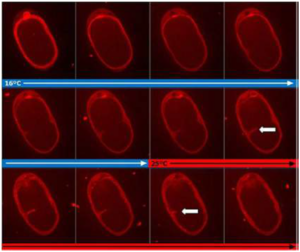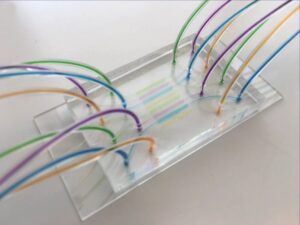Through chromosomes tracking during C. elegans embryo, news findings on their conformation and the function of lamina in chromosomes stretching
To better understand chromosome segregation Ahilya N. Sawh et al. worked on Caenorhabditis elegans embryogenesis and developed a chromosome tracking method. They notice an early barbell-like organization showing that not all epigenetically similar domains were consolidated in space. This organization come from lamina tethering which overrides homotypic B-compartment interactions in early C. elegans embryo. They conclude that tethering to the lamina stretching chromosomes over any genomic distances allowing the barbell organization. These findings highlight a new main role of the lamina and also new conformations during early embryogenesis.

Ultra fast temperature shift device for in vitro experiments under microscopy
Abstract
Current models suggest that chromosome domains segregate into either an active (A) or inactive (B) compartment. B-compartment chromatin is physically separated from the A compartment and compacted by the nuclear lamina. To examine these models in the developmental context of C. elegans embryogenesis, we undertook chromosome tracing to map the trajectories of entire autosomes. Early embryonic chromosomes organized into an unconventional barbell-like configuration, with two densely folded B compartments separated by a central A compartment. Upon gastrulation, this conformation matured into conventional A/B compartments. We used unsupervised clustering to uncover subpopulations with differing folding properties and variable positioning of compartment boundaries. These conformations relied on tethering to the lamina to stretch the chromosome; detachment from the lamina compacted, and allowed intermingling between, A/B compartments. These findings reveal the diverse conformations of early embryonic chromosomes and uncover a previously unappreciated role for the lamina in systemic chromosome stretching.
References
FAQ
Current models of chromosome organisation are based on segregation. It is suggested that chromosome domains are separated into two types. These are known as the active (A) compartment and the inactive (B) compartment. In this conventional model, the B-compartment chromatin is physically separated from the A compartment. This B-compartment is also compacted. This compaction is understood to be caused by the nuclear lamina. These models were examined in the developmental context of C. elegans embryogenesis. A chromosome tracing method was undertaken. This was done to map the trajectories of entire autosomes during this early period. The study was performed to better examine chromosome segregation.
An organisation of chromosomes that is different from conventional models was observed in early C. elegans embryos. This configuration was described as barbell-like. A chromosome tracking method was developed to map the paths of entire autosomes. This mapping revealed the specific shape. The barbell configuration was found to consist of two B compartments. These compartments were densely folded. They were separated by a central A compartment. This observation is an important one because it showed that not all domains that are epigenetically similar were consolidated in space. This arrangement differs from the conventional models of A/B segregation. Unsupervised clustering also revealed subpopulations with different folding properties. The positions of compartment boundaries were also found to be variable.
The barbell-like conformations were found to be reliant on a specific mechanism. This organisation is the result of tethering to the nuclear lamina. This tethering to the lamina stretches the chromosome. It is concluded that this stretching occurs over genomic distances, which is what permits the barbell organisation to form. This lamina tethering was also found to override homotypic B-compartment interactions. This is a new primary function identified for the lamina. The findings reveal a previously unappreciated function for the lamina. This function is described as systemic chromosome stretching, rather than just compaction.
The conformations of the early embryonic chromosomes were shown to depend on their connection to the lamina. The effect of detachment from the lamina was also examined. When this detachment occurred, the chromosome was observed to become compacted. A second effect was also noted. The separation between the A and B compartments was lost, and they were allowed to intermingle. This result supports the conclusion that the tethering to the lamina is responsible for stretching the chromosome. This stretching is what maintains the barbell organisation found in early C. elegans embryos. These findings show the diverse conformations that chromosomes can adopt.




